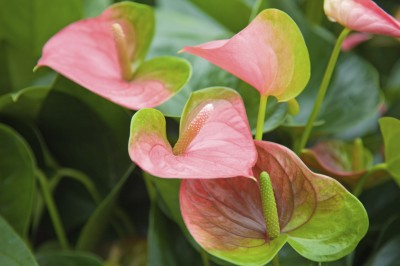






Anthuriums are in the Arum family and encompass a group of plants with 1,000 species. Anthuriums are native to South America and are well distributed in tropical regions such as Hawaii. The plant produces a flower-like spathe with a well-developed spadix in traditional hues of red, yellow and pink. More colors have recently been introduced into cultivation and you can now find green and white, scented lavender and a deeper yellow colored spathe. When your anthurium flowers turn green, it may be species or it may be age or incorrect cultivation.
Anthuriums grow in trees or compost rich soil in tropical jungle regions where shade is dense. They have come into cultivation because of the glossy green leaves and long lasting inflorescence. Growers have manipulated the plants into hues that span the rainbow and include green. They also fool plants for retail into blooming using hormones. This means that once brought home and no longer exposed to the hormones, the plant will revert to normal growth behavior. For this reason, color change in anthuriums is not unusual.
“My anthurium turned green” is a common complaint due to greenhouse practices. They often force the plant into flower when it is not ready to bloom. The plant may respond by losing color as it ages. The spathe may also fade to green if it doesn’t get a long enough dormancy period in its second flowering. This means it didn’t get exposed to the proper light intensity and duration. The plant will respond by producing faded or green flowers.
Other cultivation practices can make the plant unhappy and cause color change in anthuriums, such as improper watering, excess nitrogen fertilizer and improper temperatures. They require daytime temps between 78 and 90 F. (25-32 C), but anything higher than 90 and the flowers begin to fade.
Old age isn’t kind to any of us and this is true of flowers as well. The anthurium spathe will fade as it ages. The inflorescences generally last a month in good growing conditions. After that period, changing anthurium color begins as the spathe loses color. Streaks of green begin to appear and the overall base color will become paler.
Eventually, the spathe will die and you can cut it off and grow the plant on as a lovely and novel foliage houseplant or start the process to force more blooms. This is not a fool-proof process and requires you to give the plant a 6-week rest period in a cool room with temperatures around 60 degrees Fahrenheit (15 C).
Provide very little water and bring the plant out after the waiting period is over. This will break the dormancy cycle and signal to the plant that it is time to produce flowers.
An anthurium turning green could be any of the above causes or it could simply be the variety. A variety called Centennial starts as a white spathe and gradually turns a bright green. Other varieties that turn green are: A. clarinarvium and A. hookeri.
One that has bi-colored spathes and may appear to be fading to green is the pink obaki or Anthurium x Sarah.
As you can see, there are many possible reasons when anthurium flowers turn green. First check your species and then review your cultivation practices. If all else fails, enjoy the brilliant green spathes and the glossy foliage as just another wonderful aspect of this lovely plant.
Copyright © www.100flowers.win Botanic Garden All Rights Reserved